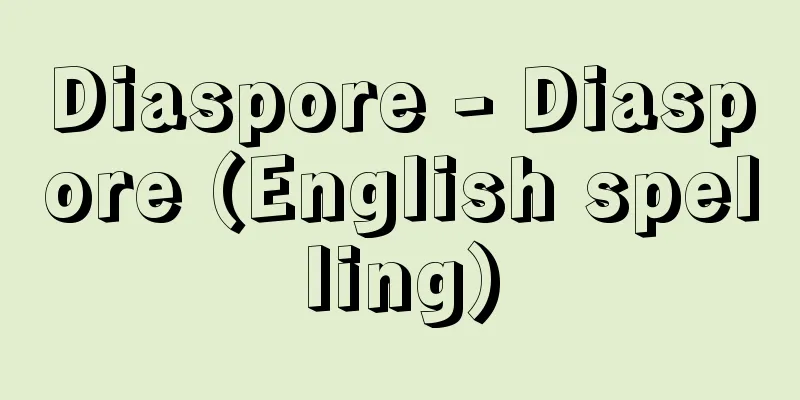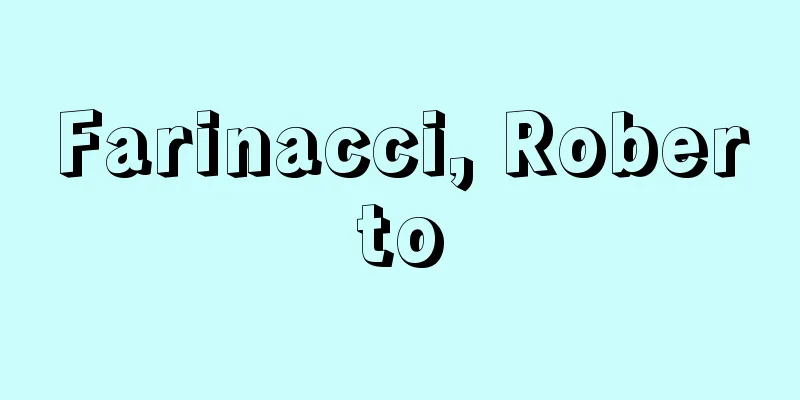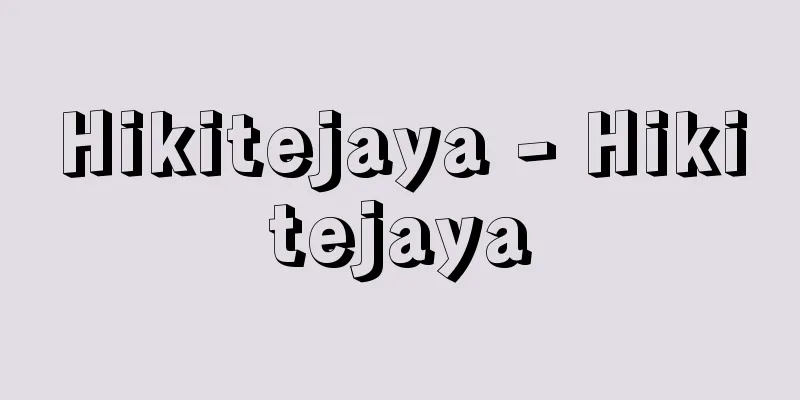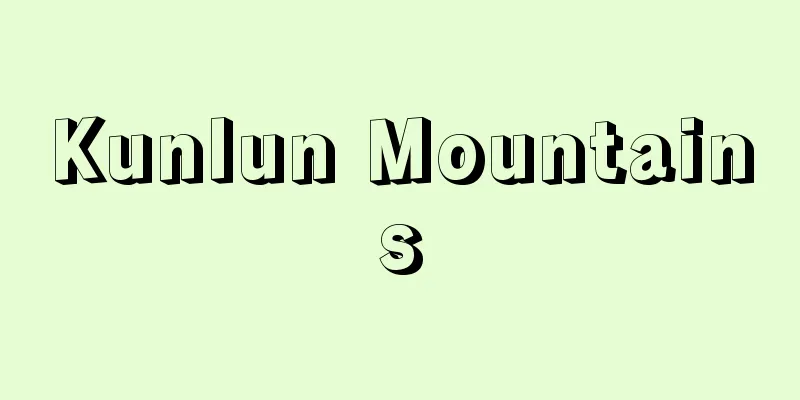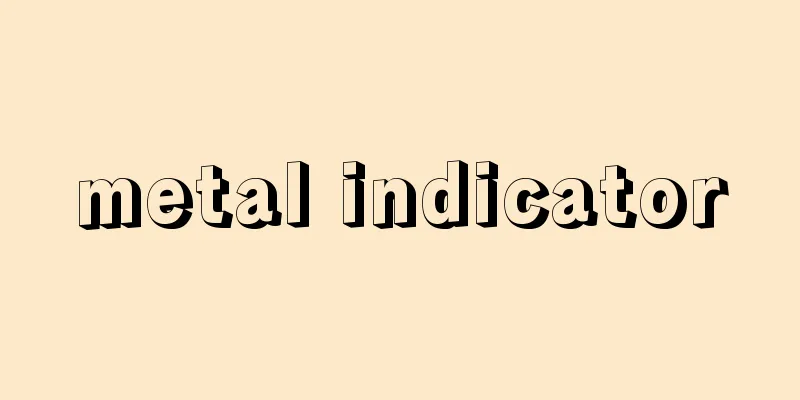Ecuador - Ecuador (English spelling)
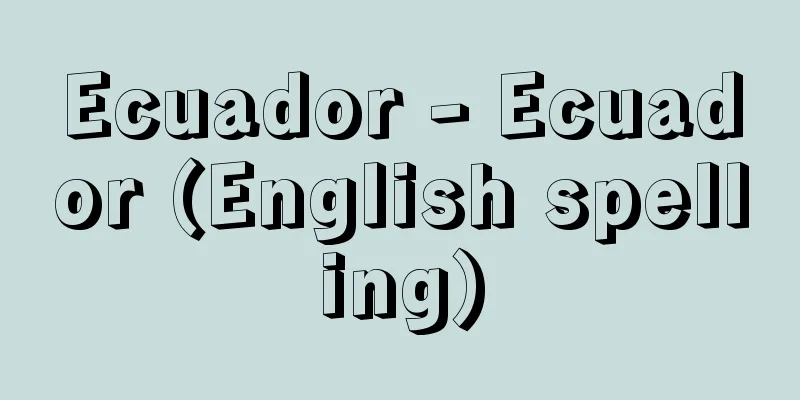
|
A country in the northwest of South America. Its official name is the Republic of Ecuador (República del Ecuador). The country's name means "equator" in Spanish, and the equator runs through the northern part of the country. Although blessed with rich agricultural and mineral resources, it is one of the least developed countries in South America. It has an area of 283,560 square kilometers, a population of 12,156,608 (2001 census), 13,363,600 (2005 estimate), and a population density of 47 people per square kilometer (2005 estimate). The capital is Quito. [Shozo Yamamoto] NatureLocated on the west coast of South America, it is sandwiched between Colombia to the north and Peru to the south and east, and faces the Pacific Ocean. The Andes Mountains run north to south through the center of the country, and the natural environment is divided into the lowlands along the Pacific coast, the Andean plateau, and the Sierra region on the eastern foot of the Andes, which are called the Costa (coastal area), the Sierra (the central mountain range and the plateau basins between them), and the Oriente (the lowlands upstream of the Amazon River in the east). The coastal Costa is flat, and the Esmeraldas River flows north from the Andes Mountains, and the Guayas River flows south. The latter forms a fertile alluvial plain, and Ecuador's largest city, Guayaquil, is located at its mouth. The coastal plain stretches for about 680 km along the Pacific coast, and between this coastal plain and the fertile Guayas River basin, there are low hills made of crystalline rock. In the south, on the border with Peru, and north of the Guayas River, there is a dry area close to a desert. The Sierra consists of the Eastern and Western mountain ranges, each exceeding 4,000 meters above sea level. The Eastern mountain range contains the world's highest active volcano, Cotopaxi (5,896 meters), and Cayambe (5,790 meters), while the Western mountain range contains the country's highest peak, Chimborazo (6,310 meters), and there are eight volcanoes over 5,000 meters. These high peaks are capped by glaciers, even though they are located directly on the equator. Between the two mountain ranges are mountain basins with heights of 2000 to 3000 meters, and many cities, including the capital Quito, have developed in this area. Earthquakes occur frequently, sometimes violently, and a major earthquake in 1949 destroyed the town of Ambato. Many long rivers flow eastward into the Oriente and empty into the Amazon River. Covered by tropical rainforest, the area has no roads and has been almost completely developed. The Amazon River basin, which extends to Iquitos, was once considered Ecuadorian territory, but due to a border dispute, nearly half of the country's land area became Peruvian territory. Nevertheless, the Oriente occupies about half of Ecuador's territory. The Galapagos Islands (also called the Colon Islands), located in the eastern Pacific Ocean 1000 kilometers west of the Ecuadorian coast, are also Ecuadorian territory. Due to the ocean currents, the islands are a treasure trove of plants and animals, and provided important material for Darwin's theory of evolution. Due to its low latitude and complex topography, there are large regional differences in climate. However, temperature changes are very small due to the latitude, and the difference in temperature between day and night, or between sun and shade, is much greater. Even in Quito, located at an altitude of 2,812 meters, the annual difference in monthly average temperature is only 0.4°C. In the coastal lowlands, there is a transitional zone of climate from the rainy north to the dry south. Inland Oriente has a hot and humid climate, typical of the Amazon lowlands directly under the equator. This diversity of climate provides a treasure trove of plants and animals. Ecuador's forests are home to a large variety of particularly useful plants, but they have not been developed due to poor transportation and transport. [Shozo Yamamoto] historyIn ancient times, eight separate Indian nations existed, but in the first half of the 15th century, the Kingdom of Quito established its rule, which continued until it was conquered by the Inca Empire in 1460. The Inca Empire was also conquered and destroyed by Spain in 1532, and the following year it officially became a Spanish colony. Initially it belonged to the Viceroyalty of Peru, and in 1717 it came under the jurisdiction of the Viceroyalty of New Granada, but due to differences in customs and geographical isolation, it formed its own Audiencia (a higher judicial, legislative, and administrative body) in 1563, and its jurisdiction became the basis of today's territory. The independence movement began with rebellions in 1809 and 1810, but it was not until 1822 that Ecuador completely broke away from Spanish rule. As a result, Ecuador was incorporated into the Republic of Gran Colombia, but separated in 1830, with Juan Jose Flores (1800-1864) as its first president. After independence, regional conflicts between the city of Guayaquil, which was dominated by merchants and industrialists, and the city of Quito, which was dominated by semi-feudal landlords, as well as conflicts and civil wars between the Liberal and Conservative parties based on these conflicts, and border conflicts with Peru and Colombia continued, and except for some progress during the three major dictatorships of Flores immediately after independence, Gabriel Garcia Moreno (1821-1875) in the late 19th century, and Eloy Alfaro Delgado (1842-1912) in the early 20th century, the development of a modern nation was hindered until the late 1940s. In May 1944, a rebellion by the left-wing Democratic League overthrew the dictatorial regime of Carlos Alberto Arroyo del Rio (1893-1969), and in the presidential elections of July of the same year, Velasco Ibarra, supported by the League, was elected. He also ran for president in the 1960 elections on a platform of progressive policies such as land reform, but after assuming office he strengthened his dictatorial tendencies, pushing ahead with tax increases, devaluation of the national currency, and oppression of anti-government movements, which led to a student and military rebellion in November 1961, forcing him into exile. Carlos Julio Arosemena Monroy (1919-2004), who was promoted from vice president, implemented progressive policies such as progressive income tax and land reform, and in foreign affairs he aimed for an independent course while maintaining cooperation with the United States. However, after succumbing to domestic right-wing forces and pressure from the United States, the government broke off diplomatic relations with Cuba in March 1962, which led to growing criticism of the government within the country. In the midst of this, the military, dissatisfied with the pro-communist tendencies, staged a coup in July 1963, suspending the constitution, dissolving the parliament, outlawing the Communist Party, and forming a Military Political Committee headed by Colonel Ramon Castro Jijon (1915-1984). This military government drew up and promoted economic development policies such as the Ten-Year Economic and Social Development Plan, but due to the resentment of politicians and students against the military dictatorship, as well as the worsening economic situation, it decided to transition to civilian rule, and in March 1966 handed power over to Senator Clemente Yerovi Indaburu (1904-1981). Aiming for an early return to constitutionalism, the provisional government held a constituent assembly election in 1966, and Otto Arosemena Gomez (1925-1984) of the ruling Social Christian Movement (CID) party was elected provisional president. However, political instability and economic crisis did not subside, and Velasco Ibarra returned to the presidency in the March 1968 election. Amid frequent land demands by Indian farmers in the mountainous regions and anti-government protests by students and workers, the Velasco government, with the cooperation of the military, opposed the left wing, announcing a plan to reorganize Ecuador into a "cooperative" state, dissolving the parliament and suspending the constitution. This resulted in increased opposition from the left wing, and in 1971 a major strike involving 100,000 workers took part. In February 1972, the military finally gave up on President Velasco and exiled him to Argentina in a bloodless coup, and Chief of the Joint Chiefs of Staff Guillermo Rodriguez Lara (1923- ) became president himself. In January 1976, he also resigned and was replaced by a Council of Governors consisting of the commanders-in-chief of the Army, Navy and Air Force, with Vice Admiral Alfredo Poveda Burbano (1926-1990) as its chairman. The Poveda administration then prepared for the transfer of power to civilian rule, and held a national referendum on the adoption of a constitution on January 15, 1978. As a result, the proposed amendments to the 1945 Constitution were rejected, and a new constitution was adopted that included new provisions such as a unicameral National Assembly, the right to vote for illiterate citizens, and a ban on the reelection of the president. [Shozo Yamamoto] PoliticsIn April 1979, Jaime Roldos Aguilera (1940-1981) of the Popular Force Concentration Party (CFP) was elected president, restoring civilian rule. He formulated a five-year national development plan aimed at expanding social justice, while in foreign affairs he cooperated with the free camp and worked to strengthen relations with socialist countries, restoring diplomatic relations with Cuba and China. After the president's death in an accident in May 1981, Osvaldo Hurtado Larrea (1939- ) of the Popular Democratic Party (DP) was elevated to the presidency. After that, political parties came and went, and in the 1984 election Leon Febres Cordero (1931-2008) of the Christian Social Party (PSC) was elected, and in 1988 Rodrigo Borja Cevallos (1935- ) of the Democratic Left Party (ID) was elected. In 1990, Brazil joined the Rio Group of major Latin American countries. In 1992, Sixto Duran Ballen Cordovez (1921-2016) of the Republican Union Party (PUR) was elected and took power, but political instability continued, and in January 1995 a border conflict broke out with Peru. Abdala Bucaram Ortiz (1952- ), of the Ecuadorian Roldos Party (PRE), who was elected president in 1996, made his first official visit to Peru in January 1997 and signed an agreement to restore relations between the two countries. However, criticism of corruption among bureaucrats, including the president, and the implementation of austerity policies grew within the country, and in February of the same year, the National Assembly passed a resolution to impeach the president, and Fabian Ernesto Alarcon Rivera (1949- , belonging to the Alfaro Radical Front Party: FRA), the president of the Senate, became interim president in place of Bucaran. In April of the same year, Alarcon began border demarcation negotiations with Peru. Jamil Mahuad Witt (1949- ), of the People's Democratic Party (DP), was elected president in August 1998. In October of the same year, he signed a comprehensive peace agreement with Peru, and in December, border demarcation began (final border demarcation in May 1999). The Mahua administration worked on fiscal reconstruction, but in January 1999, the Brazilian currency, the sucre, plummeted due to the devaluation of the Brazilian currency, leading to a currency crisis, and the government implemented austerity measures. However, the people rebelled against the government's policies, and protest demonstrations took place all over the country. The sucre continued to fall, and in January 2000, the government declared a state of emergency and announced a policy to dollarize the currency. However, abolishing the sucre and dollarizing the currency would be a huge blow to indigenous people and ordinary citizens who only had domestic assets, so the protests intensified and developed into a coup d'état. In the end, Mahua was ousted, and on January 22 of the same year, Vice President Gustavo Noboa Bejarano (1937-2021, belonging to the People's Democratic Party) was appointed president. The Noboa administration passed the Basic Law on Dollarization and Economic Transformation, the Investment Promotion and Citizen Participation Law, and obtained a loan agreement from the International Monetary Fund (IMF), promoting economic reform and fiscal reconstruction. On April 1, the dollar became the official currency, and on September 9, the sucre was abolished (the final deadline for exchanging sucre for dollars was March 2001). In the 2002 presidential election, Lucio Edwin Gutierrez Borbua (1957- ) of the Patriotic Social January 21 Party (PSP) was elected, and on January 15, 2003, he became president, and a coalition cabinet with the Indigenous Peoples Alliance party Pachakutik was formed. The Gutierrez administration embarked on fiscal reform, but Pachacutic opposed the austerity policy implemented in cooperation with the IMF, and in August of the same year, Pachacutic left the coalition government. Gutierrez's austerity policies were met with strong opposition from the general public, especially indigenous people, labor unions, and social organizations, leading to intensified anti-government protests across the country and a decline in support from the poor, his main support base. In December 2004, the Congress replaced a Supreme Court judge who was sympathetic to the opposition, which further heightened criticism, and demonstrations calling for the president's resignation gradually grew, leading to the declaration of a state of emergency. On April 20, 2005, Gutierrez was impeached, and Vice President Alfredo Palacio Gonzalez (1939- ) became president. The Palacios administration is working on political reforms such as ensuring the independence of the judiciary and introducing a single-seat constituency system, as well as developing infrastructure, strengthening the health and education sectors, strengthening the legal system, and improving public safety. However, corruption and conflicts among bureaucrats have led to successive changes in ministers, and political administration remains unstable. The National Assembly is unicameral with 100 members, and the term of office is four years. The judicial power is exercised by the Supreme Court, the High Court and the lower courts, and there is no death penalty. Local government is divided into provinces, prefectures and districts. There are 21 provinces. Provincial governors are appointed by the president. Political parties include the Patriotic Social 1/21 Party (PSP, center-left), the Christian Social Party (PSC, right-wing), the Democratic Left Party (ID, center-left), the Ecuadorian Roldos Party (PRE, center-left), the Pachakutik Party (PNP, left-wing), the National Action Party for Institutional Reform (PRIAN, right-wing), and the People's Democratic Party (DP, right-wing). The military consists of the army (which accounts for two-thirds of the defense budget), the navy and the air force, and the president is the commander-in-chief. Men between the ages of 18 and 50 are required to serve in the military for one year. [Shozo Yamamoto] Economy and IndustryIt is one of the most economically underdeveloped countries in South America, with only 24.5% of the population employed in agriculture, forestry and fishing (2002). The semi-feudal system of large landowners and the domination of American capital are the main reasons for its economic backwardness. The agricultural regions are roughly divided into the grain-producing areas in the plateau basin, which are managed by small-scale farms and have low productivity, and the tropical and temperate agricultural product areas in the coastal areas, which are managed by large-scale farms. In the latter areas, the cultivation of export crops such as bananas, coffee, cacao, and cotton is thriving, taking advantage of the fertile soil and varied climate. Large-scale cattle farming is carried out in the pastures of the central highlands. In addition, the cultivation of flowers for export has rapidly developed. Bananas, the most important agricultural product, had a plateau in the early 1980s due to stagnant overseas demand, but it has since recovered, with production reaching 6,038,000 tons (fourth in the world) and exports reaching 4,699,000 tons (first in the world) in 2004. In the late 1970s, the export value of coffee exceeded that of bananas due to the rise in international prices, but in recent years, the export value of coffee has been decreasing due to sluggish international prices and a slight decrease in production. Cacao production is 123,000 tons (2005) and is showing a slight increase. Mineral resources are known to be abundant, but their development has been delayed. However, oil has been developed rapidly since 1971, mainly in the eastern region, and it is now the country's number one export (2003). The oil produced is transported about 500 kilometers from Lago Agrio to Esmeraldas on the Pacific coast via a pipeline across the Andes, which was completed in 1972. Forest resources are abundant in the Amazon lowlands and coastal areas, and balsa wood and ivory nuts are known as special products, but many areas remain undeveloped due to transportation bottlenecks. Industry is sluggish despite the government's protective policies, and basic consumer goods such as food, textiles, and cement still account for a large proportion of the country's exports. In terms of trade, exports were $9.8 billion and imports were $8.6 billion (2005), resulting in a trade surplus of approximately $1.2 billion. Major export items include petroleum, bananas, fresh flowers, shrimp, cacao, and coffee, while the majority of imports are machinery, automobiles, and electrical machinery. The United States accounts for 30-40% of trade. [Shozo Yamamoto] Society and CultureNative Americans (Indians) and mestizos, a mix of natives and whites of southern European descent, mainly Spanish, make up about three-quarters of the total population, making it one of the most Indian-dominated countries in South America. Whites, mostly Spanish (creoles), about 10%, natives about 7%, blacks and mulattos, a mix of blacks and whites, about 5%. Whites live in the cities of the plateau and form the upper class, such as large landowners and merchants and industrialists, mestizos make up the urban middle class, and blacks are mainly plantation workers. Indians live as serfs, mainly on large semi-feudal lands. The gross national product per capita is $2,502 (2005), but like other South American countries, the gap between rich and poor is extremely large. The cities have many poor people, and the poverty problem is getting worse every year. Therefore, the labor movement is active, and even today there are frequent demonstrations and strikes against dismissals, non-payment of wages, and rising prices. In rural areas, struggles demanding land reform and land occupation movements are active. Primary and secondary education is free (public only) and compulsory from age 5 to 15, but approximately 9% of the population is illiterate. Spanish is the national and official language, but many Indians speak Quechua. Indigenous languages such as Jivaro, Zaparo, and Tukano remain in the Oriente region. Culturally, there is a strong Spanish influence, and Catholicism is widespread. Although separation of church and state is a maxim, the Catholic Church is a major landowner and a major force in political matters. [Shozo Yamamoto] Relations with JapanDiplomatic relations were temporarily suspended during World War II, but since the ratification of the Peace Treaty in 1954 (Showa 29), the two countries have maintained a friendly relationship. There are 408 Japanese nationals residing in Ecuador (2004), with most of them living in the El Bosque district in the north of Quito, the area around Carolina Park, and the González Suárez district. Trade between the two countries is such that exports to Japan amount to 30.6 billion yen and imports to Japan amount to 18.3 billion yen (2004), resulting in a trade surplus for Japan of approximately 12.3 billion yen. Major exports to Japan include bananas, oil, and shrimp, while imports to Japan include automobiles, general machinery, automobile parts, and electrical equipment. In terms of economic cooperation, up until fiscal 2004, Japan had provided 81.3 billion yen in loan aid (yen loans) for projects such as the Quito and Guayaquil thermal power plant installation plans and the telecommunications network expansion plan, 22.1 billion yen in grant aid for food production increase assistance, disaster emergency assistance, groundwater development, etc., and 16.8 billion yen in technical cooperation. Japan has also accepted 140 Ecuadorian technical trainees, dispatched 235 experts, dispatched 1,083 survey teams, and dispatched 321 cooperation volunteers. [Shozo Yamamoto] "Encyclopedia of Latin America" (1996), edited and published by the Latin American Association. ▽ "Companies and Industrial Development in Latin America" (1996, edited by Hoshino Taeko, published by the Institute of Developing Economies and the Asian Economic Publishing Company)" ▽ "World Geography 5: South America" (1997, Asakura Publishing) edited by Tanabe Yutaka. ▽ "World Geography Encyclopedia 3: North and South America" (1999, Asakura Publishing) edited by Tanabe Yutaka. ▽ "The Sky of Ecuador" (1999, Toyo Publishing) by Tokita Yumi. ▽ "Exploring 10 Latin American Countries: A World of Abundance and Poverty" (1999, Shinhyoron Publishing) by Suzuki Takahisa . ▽ "Latin American History 2: South America" (2000, Yamakawa Publishing) edited by Masuda Yoshiro . "Junpei Juri, 'Ecuador - The Land of Galapagos, Noguchi, and Panama Hats' (2005, Toyo Shoten)" [References] | | | | | | | | | [Additional Resources] |"> Ecuador flag ©Shogakukan Illustration/Shogakukan Creative "> Ecuador Location Map Source: Shogakukan Encyclopedia Nipponica About Encyclopedia Nipponica Information | Legend |
|
南アメリカ大陸北西部の国。正式名称はエクアドル共和国República del Ecuador。国名はスペイン語で「赤道」を意味し、国土の北部を赤道が通っている。豊かな農産物と鉱産資源に恵まれながらも、南アメリカで国土開発がもっとも遅れた国の一つである。面積28万3560平方キロメートル、人口1215万6608(2001年センサス)、1336万3600(2005年推定)、人口密度は1平方キロメートル当り47人(2005年推定)。首都はキト。 [山本正三] 自然南アメリカ大陸の西海岸に位置し、北はコロンビアに、南と東はペルーに挟まれ、太平洋に面する。国の中央をアンデス山脈が南北に走り、自然環境上は太平洋岸の低地帯と、アンデス高原およびアンデス山脈東麓(とうろく)のシフの地域に区分され、それぞれコスタ(海岸地帯)、シエラ(中央山地とその間に連なる高原盆地群)、オリエンテ(東部のアマゾン川上流の低地帯)とよばれる。 海岸部のコスタは平坦地(へいたんち)で、アンデス山脈から北に流れるエスメラルダス川、南に流れるグアヤス川があり、とくに後者は肥沃(ひよく)な沖積平野を形成し、エクアドル最大の都市グアヤキルもその河口にある。海岸平野は太平洋岸に沿って680キロメートルほど続き、この海岸平野と肥沃なグアヤス川流域との間には結晶質の岩石からなる低い丘陵地がある。また南部のペルー国境、グアヤス川の北には砂漠に近い乾燥地帯が発達している。シエラは標高4000メートルを超える東部・西部両山系からなる。東部山系には世界最高の活火山コトパクシ火山(5896メートル)、カヤンベ火山(5790メートル)、西部山系には同国最高峰のチンボラソ火山(6310メートル)など、5000メートル級の火山が8峰もある。これらの高峰は赤道直下にありながら氷河を頂いている。両山系の間には2000~3000メートルの高さの山間盆地が並び、首都キトをはじめ多くの都市がこの地帯に発達している。地震が頻繁におこり、ときには激烈なものもあり、1949年の大地震はアンバトの町を壊滅させた。オリエンテには、多数の長流が東流しアマゾン川に注いでいる。熱帯雨林に覆われ、道路も未整備で、開発はほとんど行われていない。かつてはイキトスにまで及ぶアマゾン川流域がエクアドル領とされていたが、国境紛争で国土の半分に近い領土がペルー領となった。それでもオリエンテはエクアドル領土の約半分を占める。エクアドル海岸から西へ1000キロメートルの東太平洋上にあるガラパゴス諸島(コロン島ともよばれる)もエクアドル領である。同諸島は海流の関係で動植物の宝庫となっており、ダーウィンの進化論に重要な材料を提供した。 低緯度でしかも地形が複雑なので、気候の地域的な差は大きい。しかし、気温の変化は緯度の関係上非常に小さく、昼夜あるいは日なたと日陰の気温の差のほうがずっと大きい。標高2812メートルの高所にあるキトでも、月平均気温の年較差はわずかに0.4℃しかない。海岸の低地では、雨の多い北部から乾燥した南部へと気候の漸移地帯が存在する。内陸のオリエンテは暑く湿潤で、赤道直下のアマゾン低地の典型的な気候である。このような気候の多様性は動植物の宝庫を提供している。エクアドルの森林中にはとくに有用植物の種類が非常に多いが、交通や輸送が不便なために開発に至っていない。 [山本正三] 歴史古くは八つのインディオ国家が分立していたが、15世紀前半にキト王国の支配が確立、同国は1460年にインカ帝国に征服されるまで続いた。インカ帝国も1532年にスペインに征服されて滅亡し、翌年正式にスペイン領植民地となった。当初ペルー副王領に属し、1717年以降はヌエバ・グラナダ副王領の管轄下に入ったが、習俗の相違や地理的隔絶のために1563年以来独自のアウディエンシア(上位の司法立法行政機関)を形成しており、その管轄区が今日の領土の基盤となった。 独立運動は1809年および1810年の反乱に始まるが、スペインの支配を完全に脱したのは1822年である。それに伴い、エクアドルは大コロンビア共和国に編入されたが、1830年には分離独立し、初代大統領にはホセ・フロレスJuan Jose Flores(1800―1864)が就任した。独立後は、商工業主中心のグアヤキル市と半封建地主を中心とするキト市との地域的対立、それを基盤とする自由・保守両党の紛争および内乱、ペルー、コロンビアとの国境紛争などが続き、独立直後のフロレス、19世紀後半のモレノGabriel Garcia Moreno(1821―1875)、20世紀初頭のアルファロEloy Alfaro Delgado(1842―1912)の三大独裁時代における若干の発展を除けば、1940年代後半に至るまで近代国家の発展は阻まれてきた。 1944年5月、左派の民主連盟による反乱でアロヨ・デル・リオCarlos Alberto Arroyo del Rio(1893―1969)独裁政権が倒れ、同年7月の大統領選挙では同連盟の推すベラスコ・イバラが当選した。彼は1960年選挙にも土地改革などの進歩的政策を掲げて当選したが、就任後は独裁的傾向を強め、増税、平価切下げ、反政府運動弾圧などを進めたため、1961年11月、学生、軍の反乱が起こり、亡命を余儀なくされた。副大統領から昇格したフリオ・アロセメナCarlos Julio Arosemena Monroy(1919―2004)大統領は累進所得税、農地改革など進歩的政策を実行し、外交的には対米協調を基本としながらも自主路線を目ざした。しかし国内右翼勢力とアメリカの圧力に屈して、1962年3月対キューバ断交に踏み切ると、国内の政府批判が高まった。そうしたなかで1963年7月、容共的傾向を不満とする軍部がクーデターを断行し、憲法の停止、議会の解散、共産党の非合法化を行うとともに、ラモン・カストロ・ヒホンRamon Castro Jijon(1915―1984)大佐を首班とする軍部政治委員会を組織した。同軍事政権は経済社会発展十か年計画などの経済開発政策を立案、推進したが、軍部の独裁に対する政治家や学生の反感に加えて、経済情勢が悪化したため、民政移行を決意、1966年3月、イエロビ・インダブロClemente Yerovi Indaburu(1904―1981)上院議員に政権を委譲した。 立憲制早期復帰を目ざす同臨時政権は、1966年、制憲議会選挙を施行、与党社会キリスト教運動党(CID)のアロセメナ・ゴメスOtto Arosemena Gomez(1925―1984)が臨時大統領に選出された。しかし政情不安と経済危機は去らず、1968年3月の選挙でベラスコ・イバラが大統領に復帰した。山地のインディオ農民の土地要求運動や、学生、労働者の反政府運動が頻発するなかで、ベラスコ政権は軍部の協力を得て左派に対抗、エクアドルを「協同組合」国家に再編する構想を発表し、議会の解散と憲法の停止を断行した。これが左派の反発を強める結果となり、1971年には10万人の労働者が参加する大ストライキが起きた。1972年2月、軍部はついにベラスコ大統領を見限り、無血クーデターで彼をアルゼンチンに追放し、ロドリゲス・ララGuillermo Rodriguez Lara(1923― )統合参謀長自身が大統領に就任した。1976年1月には同大統領も退陣し、かわって陸海空三軍最高司令官よりなる執政評議会が成立、アルフレッド・ポベダ・ブルバーノAlfredo Poveda Burbano(1926―1990)海軍中将がその議長となった。ポベダ政権はその後民政移管の準備を進め、1978年1月15日に憲法採択のための国民投票を実施した。その結果、1945年憲法の改正案は退けられ、国会の一院制、非識字国民への選挙権付与、大統領の再選禁止などの新規定を盛った新憲法案が採択された。 [山本正三] 政治1979年4月、選挙で人民勢力集中党(CFP)のハイメ・ロルドス・アギレーラJaime Roldos Aguilera(1940―1981)候補が大統領に当選、文民政治が回復した。彼は社会公正の拡大を目ざした国家開発五か年計画を策定する一方、外交では自由陣営との協調とともに社会主義諸国との関係強化に努め、キューバ、中国と国交を回復した。1981年5月の大統領事故死のあと、人民民主党(DP)のウルタード・ラレアOsvaldo Hurtado Larrea(1939― )が大統領に昇格した。その後は政党の離合集散が激しく、1984年の選挙ではキリスト教社会党(PSC)のレオン・フェブレスLeon Febres Cordero(1931―2008)が、1988年には民主左翼党(ID)のボルハRodrigo Borja Cevallos(1935― )が当選した。1990年に中南米主要国のリオ・グループに加盟。1992年共和連合党(PUR)のドゥラン・バジェンSixto Duran Ballen Cordovez(1921―2016)が当選し政権についたが、以後も不安定な政局が続き、1995年1月にはペルーとの間で国境紛争が起こった。1996年の大統領選挙で当選したエクアドル・ロルドス党(PRE)のブカランAbdala Bucaram Ortiz(1952― )は、1997年1月初めてペルーを公式訪問し両国の関係修復のための協定に調印した。しかし国内では大統領を含む官僚の汚職問題や緊縮政策断行に対する批判が高まり、国会は同年2月大統領弾劾を決議、ブカランにかわって上院議長のアラルコンFabian Ernesto Alarcon Rivera(1949― 、所属はアルファロ急進戦線党:FRA)が暫定大統領となった。同年4月アラルコンはペルーとの国境画定交渉を開始した。その後1998年8月大統領に選出された人民民主党(DP)のマワJamil Mahuad Witt(1949― )は、同年10月ペルーとの和平包括協定に調印し、12月より国境画定作業に入った(1999年5月国境線最終画定)。マワ政権は財政再建に取り組んだが、1999年1月ブラジル通貨切下げの影響により通貨スクレが暴落、通貨危機が発生し、政府は緊縮政策を行った。しかし政府の政策に国民は反発、各地で抗議デモが行われた。その後も通貨スクレは下落し、2000年1月政府は非常事態を宣言、通貨ドル化政策を発表したが、スクレを廃止し通貨をドル化することは国内資産しかもたない先住民や一般市民には大打撃となるため、抗議デモが激化しクーデターに発展した。結局マワは失脚し、同年1月22日副大統領のノボアGustavo Noboa Bejarano(1937―2021、所属は人民民主党)が大統領に指名された。ノボア政権はドル化経済変革基本法、投資促進・市民参加法などを成立させ、国際通貨基金(IMF)からの融資合意を取り付け、経済改革を推進し財政再建を図った。4月1日よりドルが公式通貨となり、9月9日スクレは廃止された(スクレからドルへの両替の最終期限は2001年3月)。2002年の大統領選挙では愛国的社会1・21党(PSP)のグティレスLucio Edwin Gutierrez Borbua(1957― )が当選、2003年1月15日大統領に就任、先住民族同盟の政党パチャクティクとの連立内閣が発足した。グティレス政権は、財政改革に着手したが、IMFとの協調緊縮財政政策にパチャクティクは反発、同年8月パチャクティクは連立内閣から離脱した。グティレスの緊縮財政政策に対して先住民をはじめとする国民、労働組合、社会団体の反発は強く、各地で反政府抗議行動が活発化、主要支持基盤の貧困層の支持は低下していった。2004年12月、国会で野党寄りの最高裁判所判事が更迭されたことでさらに批判が高まり、大統領辞任を求めるデモはしだいに拡大、非常事態が宣言された。2005年4月20日グティレスは罷免され、副大統領のパラシオAlfredo Palacio Gonzalez(1939― )が大統領に就任した。パラシオ政権は司法権の独立確保・小選挙区制の導入などの政治改革、インフラ整備、保健・教育部門の強化、法制度強化・治安の改善などに取り組んでいるが、官僚の汚職や対立などにより大臣の交替が相次ぎ不安定な政治運営が続いている。 国会は一院制で定員100、議員の任期4年となっている。司法権は最高裁判所、高等裁判所および下級裁判所がつかさどり、死刑はない。地方行政は州、県、区に分かれる。州は21州である。州知事は大統領が任命する。政党は、愛国的社会1・21党(PSP、中道左派)、キリスト教社会党(PSC、右派)、民主左翼党(ID、中道左派)、エクアドル・ロルドス党(PRE、中道左派)、パチャクティク(PNP、左派)、制度的革新国民行動党(PRIAN、右派)、人民民主党(DP、右派)などがある。軍隊は陸軍(国防予算の3分の2を占める)、海軍、空軍からなり、最高司令官は大統領である。18~50歳までの男子には1年間の兵役義務がある。 [山本正三] 経済・産業南アメリカで経済がもっとも遅れた国の一つであり、農林・漁業就業者比率は24.5%である(2002)。半封建的大土地所有制とアメリカ資本の支配が、経済的後進性の主要因である。 農業地帯は、高原盆地における零細経営・低生産性の穀物地帯と、海岸部における大農式経営の熱帯性および温帯性農産物地帯に大別される。後者はとくに肥沃(ひよく)な地味や変化に富んだ気候を利用してバナナ、コーヒー、カカオ、綿花などの輸出用農産物の栽培が盛んである。中央高地の牧草地では大規模経営の牧牛が行われている。また、輸出向けの花の栽培が急速に発展してきた。農産物の最有力品目であるバナナは、1980年代前半は海外需要の停滞により生産が頭打ち傾向であったが、その後回復し、2004年の生産は603万8000トン(世界第4位)、輸出は469万9000トン(世界第1位)となっている。コーヒーは1970年代後半に国際価格の値上りによってバナナの輸出額を上回った時期もあったが、近年は国際価格が低迷しているうえ生産量が微減傾向にあるためコーヒーの輸出額は減少している。カカオの生産量は12万3000トン(2005)で微増傾向にある。鉱産資源はその豊富さが指摘されながら開発が遅れているが、石油は東部地方を中心に1971年以降急速に開発が進み、現在同国の輸出額で第1位(2003)を占める。産出された石油は、1972年に完成したアンデス山脈越えのパイプラインでラゴ・アグリオから太平洋岸のエスメラルダスまで約500キロメートルを輸送する。林産資源はアマゾン低地や海岸部に豊富で、バルサ材やアイボリー・ナットが特産品として知られるが、輸送上のネックのため未開発の部分が多い。工業は政府の保護政策にもかかわらず低迷しており、依然として食品、繊維、セメントなど基礎的消費材の比重が大きい。 貿易は、輸出98億ドル、輸入86億ドル(2005)で、約12億ドルの出超である。主要輸出品目は石油、バナナ、生花、エビ、カカオ、コーヒーなどで、輸入は機械類、自動車、電気機械が多い。貿易相手国はアメリカが30~40%を占める。 [山本正三] 社会・文化住民は先住民(インディオ)、および先住民とスペイン人を主とする南ヨーロッパ系白人との混血であるメスティソが、全人口の約4分の3を占め、南アメリカ諸国のなかでもっともインディオ的色彩が濃い国の一つである。スペイン人を主とする白人(クレオール)が約10%、先住民が約7%、黒人および黒人と白人との混血であるムラートが約5%を占める。白人は高原諸都市に住み大地主や商工業主など上層階級を、メスティソは都市中間層を、黒人はおもにプランテーションの労働者層を形成する。インディオは主として半封建的大土地で農奴そのままの生活を送っている。1人当りの国民総生産は2502ドル(2005)であるが、他の南アメリカ諸国と同様貧富の差はきわめて大きい。都市は多くの貧民を抱え、貧民問題は年々深刻化している。したがって労働運動は活発で、今日でも解雇、賃金不払い、物価上昇などに反対するデモ、ストライキなどが頻発している。農村では土地改革要求闘争、土地占拠運動が活発である。5~15歳までの初等・中等教育は無償(公立のみ)の義務制であるが、国民のおよそ9%は非識字者である。スペイン語が国語で公用語であるが、多くのインディオはケチュア語を用いる。オリエンテ地方には、ヒバロ語、サパロ語、トゥカノ語など土着の言語も残っている。文化的にはスペインの影響が強く、カトリックが広く普及している。政教分離をたてまえとしながらもカトリック教会は大地主で、政治面でも一大勢力である。 [山本正三] 日本との関係第二次世界大戦中、一時外交関係は中断したが、1954年(昭和29)の平和条約の批准以降、両国は友好的な関係を維持している。エクアドルにおける在留邦人数は408人(2004)で、多くがキト市北部のエル・ボスケ地区、カロリーナ公園周辺の地域、ゴンサレス・スアレス地区などに居住している。両国間の貿易は、対日輸出額306億円、対日輸入額183億円(2004)で、約123億円の日本の出超である。主要品目は対日輸出がバナナ、石油、エビなどで、対日輸入は自動車、一般機械、自動車部品、電気機器などである。経済協力では、2004年度までにキト火力発電所・グアヤキル火力発電所設置計画、電気通信網拡充計画などへの有償資金協力(円借款)813億円、食料増産援助、災害緊急援助、地下水開発などへの無償資金協力221億円、技術協力168億円を供与している。また140人のエクアドル技術研修員を受け入れたほか、235人の専門家派遣、1083人の調査団派遣、321人の協力隊派遣を行っている。 [山本正三] 『ラテン・アメリカ協会編・刊『ラテン・アメリカ事典』(1996)』▽『星野妙子編『ラテンアメリカの企業と産業発展』(1996・アジア経済研究所、アジア経済出版会発売)』▽『田辺裕監修『世界の地理5 南アメリカ』(1997・朝倉書店)』▽『田辺裕監修『世界地理大百科事典3 南北アメリカ』(1999・朝倉書店)』▽『鴇田祐美著『エクアドルの空』(1999・東洋出版)』▽『鈴木孝壽著『ラテンアメリカ探訪10カ国――豊穣と貧困の世界』(1999・新評論)』▽『増田義郎編『ラテン・アメリカ史2 南アメリカ』(2000・山川出版社)』▽『寿里順平著『エクアドル――ガラパゴス・ノグチ・パナマ帽の国』(2005・東洋書店)』 [参照項目] | | | | | | | | | [補完資料] |"> エクアドルの国旗 ©Shogakukan 作図/小学館クリエイティブ"> エクアドル位置図 出典 小学館 日本大百科全書(ニッポニカ)日本大百科全書(ニッポニカ)について 情報 | 凡例 |
<<: Equites (English spelling)
Recommend
Takamasa Okuni
Year of death: August 17, 1871 (October 1, 1871) Y...
Women's Prison - Onnarou
〘Noun〙 A prison building for female prisoners in t...
special educational needs
...The following will focus on education for chil...
Yellow Spodumene - Yellow Spodumene
…It is a type of gemstone, and is a type of spodu...
Exchange arbitrage
It is an operation to earn interest by taking adv...
Share - Mochibun
〘noun〙① The portion or percentage of the whole tha...
Flavius Valens
Roman Emperor (reigned 364-378). Born in Pannonia...
Poisonous plants - poisonous plants
A plant that contains a toxic substance in part o...
Pepper - Pepper (English spelling) Piper nigrum; pepper
An evergreen perennial vine of the Piperaceae fami...
Ayurveda - Ah, Yurubeda
… [Kenji Muraoka] [India] In the Vedic period, wh...
Bishop - English spelling: episkopos; bishop
In Christian churches that have traditional cleric...
Earl of Egmont
1522‐68 A nobleman of the Netherlands. He served u...
Kyoka - Kyoka
A literary pastime that flourished during the Edo...
Witwatersrand (English spelling)
A gold-producing region in the northern part of So...
Kaeri - Return
…They are also called Nanatsuboshi because of the...
